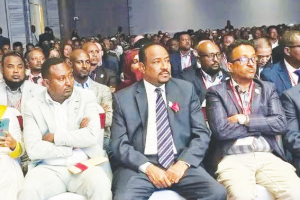Frantz Fanon, the social scientist, physician, and psychiatrist from Martinique, wrote the following in his classic work called, The Wretched of the Earth, “ If the building of a bridge does not enrich the awareness of those who work on it, then that bridge ought not to be built and the citizens can go on swimming across the river or going by boat.”
Bridge-building in this case can be taken to mean peace building and interpreted as meaning that peacebuilding should be a conscious effort by the builders themselves whose consciousness of the national challenge should be boosted by their efforts. This can also be taken as a warning against the pointlessness of bridge-building unless the builders take stoke of their project that, in the process, emancipates them mentally.
A wave of ethnic-motivated conflicts swept this country late last year and continued through the new year. These conflicts are sometimes shrouded in mysteries, blurring the line between the issues that divide various communities thereby making it extremely difficult to look for a way out of the mayhems that accompany these tragic events. When one conflict somewhere at the center seemed to abet, another one exploded somewhere in the periphery. Conflicts that appeared overcome a few months back resurface under a new guise.
Somali and Oromia regions, Benishangul Gumuz, Dire Dawa and Harari are tangible evidences of the erratic nature of the conflicts that do not positively respond to the usual conflict resolution mechanisms that are often based on what some writers call “elite bargains”. A typical case of elite bargain is the recent conflict between some renegade elements of the now defunct OLF and government troops in Western Wellega.
A number of former leaders of the movement, namely Dr. Dima Negewo who, in a recent interview with The Ethiopian Herald, denied the existence of the OLF in its original form. Various factions are now claiming allegiance to the movement, making it impossible to talk about one unified command. In this particular case, the elite bargain consisted of government representatives sitting down with their opposing counterparts and trying to hammer out their differences and achieve some kind of mutual understanding and eventual peace deal.
There have been repeated attempts at negotiating a way out of the inter-Oromo elite conflicts because these were and are usually caused by various political positions articulated by the leaderships of the respective movements or parties. The negotiations usually went well and at the end led to some kind of agreement to stop using violence and settle their differences.
No sooner that the ink on the joint declarations had dried, that the old accusations and counter-accusations resurfaced and led to renewed fighting or to a new round of peace talks or negotiations without achieving tangible peace deals. that As the talks came to a dead end, mutual acrimonies and accusations followed taking the peace efforts back to where they were before the negotiations.
Elite bargain and /or elite fragmentation is not a new phenomenon in Ethiopian politics. It existed before and exists right now but it has seldom achieved its objective because of the mutual suspicion and mistrust that characterized the positions of the negotiating parties. However, the main weakness of elite bargain it the exclusion of the masses of the people from the peace efforts. Communities were not consulted and grassroots organizations were ignored in the process.
Traditional systems of conflict resolution were likewise overlooked and the people were paying the cost of their marginalization by paying with their lives and properties for the mistakes of the elites. A breakthrough appeared on the horizon following the recent and rather successful attempt to follow a new approach to address the issues of intraethnic conflicts mainly in Oromia region.
After successive failures at achieving solid and binding peace deals, an attempt was made to involve community representatives through the Geda system and this apparently paid dividends or proved the right approach. The authority of the traditional Geda elders has taken center stage in achieving peace or a lasting settlement through a feasible strategy of grassroots participation. This event brings to mind the post-genocide political settlement in Rwanda where the Gacaca Courts or traditional system of rural tribunals was used to process the cases of hundreds of thousands of genocide suspects.
The Gacaca ourts or traditional judicial administrations set up on an ad hoc basis to process the cases of the suspects involved the victims and perpetrators of the genocide in a joint bid to achieve a feasible alternative but also led to mutual agreement between the two parties to forget the past and work together for a better future. So, the system was based on traditional African conflict resolution and it worked.
Ethiopia too has also a culture of traditional conflict resolution mechanisms through what we may call “elders bargain” in which respected members of the communities mediate between conflicting parties in a kind of village democracy. This may involve family or village affairs, criminal offenses or civil claims. The Afersata or the system of investigation used in many rural communities to find out and punish the culprit in cases of criminal offenses can be taken a rudimentary form of traditional police investigation.
Renowned Ethiopian author Sahle Selllassie Berhane Mariam (author of The Afersata and Firebrnads among others) has borrowed and used the same theme in a novel that bears the same title. By the way, Sahele Sellassie’s effort may be seen as a case of art in the service of tradition and culture. Virtually every rural communities in Ethiopia have some form of elder bargaining mechanism to settle conflicts within and outside the borders of the communities.
The problem is, these traditional structures of community-based conflict resolution mechanism were undermined by the dominant tradition of elite bargain in Ethiopian politics. The traditional culture of ‘elders bargain’ was thus considered “backward” or unfit for modern times and ignored until now. Recent events have disproved this misconception as untenable as a group of elders came together to address the issues in Oromia region and created a glimmer of hope for lasting peace or final settlement in what is considered the greatest threat to the ongoing Transitional Period in Ethiopia.
Traditional Geda elders sitting together with elite politicians to handle the differences in their own creative ways is indeed an encouraging sign that tradition and culture in Ethiopia are finding a new lease on life. sometimes one has to go back in order to go forward as they say. African societies have witnessed the disappointments of the colonial and post-colonial experiences. Post-colonial conflict settlement methods in many African countries are often borrowed or copied from the jurisdiction of the old colonial masters who imposed their legal systems on the colonized, as Franz Fanon says.
Now is the time for Africans to find their own bearings by going back in time and exploring their roots and discovering their cultural heritages in all walks of life, including conflict resolution and peacemaking. As the Gacaca judicial approach made wonders in post-genocide Rwanda, there is no reason why the Geda system of dealing with conflicts cannot be rediscovered, critically analyzed and put to good use. This is in fact what is meant by going back and discovering our roots and making good use of our cultural and traditional heritages in order to achieve lasting peace among communities.
An ounce of prevention is better than a pound of cure, as the saying goes in the medical world. By the same token, using traditional methods of conflict resolution to curb conflicts before they assume a full blown nature can be seen as a case of Ethiopian wisdom that says something like, “Extinguishing the fire with wet leaves before it consumes everything else on its path”.
Our anthropologists, sociologists and political scientists are therefore duty bound to turn their attention to a deeper study of the old traditions and cultures of our rural communities in order to resuscitate them from extinction and bring them back to life and to good use in conflict resolution and peace building. There can be no nobler and more edifying cause than saving human lives from suffering and death. As Franz Fanon said, peace-building is like bridge building. It is expected to enrich the awareness of all those involved in its building.
The Ethiopian Herald, February 10/2019
BY MULUGETA GUDETA





